Synthesis and Electrochemical Properties of Lignin-Derived High Surface Area Carbons
Abstract
:1. Introduction
2. Experimental Section
2.1. Materials
2.2. Preparation of Void@C
2.3. Preparation of C@Ni12P5
2.4. Preparation of S@C/Ni12P5
2.5. Preparation of Polyacrylic Acid Lithium Salt (LiPAA)
2.6. Material Characterization
2.7. Electrochemical Measurements
3. Results and Discussion
4. Conclusions
Author Contributions
Funding
Acknowledgments
Conflicts of Interest
References
- Braun, J.; Holtman, K.; Kadla, J. Lignin-Based Carbon Fibers: Oxidative Thermostabilization of Kraft Lignin. Carbon 2005, 43, 385–394. [Google Scholar] [CrossRef]
- Kadla, J.F.; Kubo, S.; Venditti, R.A.; Gilbert, R.D.; Compere, A.L.; Griffith, W. Lignin Based Carbon Fibers for Composite Fiber Applications. Carbon 2002, 40, 2913–2920. [Google Scholar] [CrossRef]
- Ruiz-Rosas, R.; Bedia, J.; Lallave, M.; Loscertales, I.G.; Barrero, A.; Rodríguez-Mirasol, J.; Cordero, T. The Production of Submicron Diameter Carbon Fibers by the Electrospinning of Lignin. Carbon 2010, 48, 696–705. [Google Scholar] [CrossRef]
- Chatterjee, S.; Saito, T. Lignin-Derived Advanced Carbon Materials. ChemSusChem 2015, 8, 3941–3958. [Google Scholar] [CrossRef]
- Cao, J.; Xiao, G.; Xu, X.; Shen, D.; Jin, B. Study on Carbonization of Lignin by TG-FTIR and High-Temperature Carbonization Reactor. Fuel Process. Technol. 2013, 106, 41–47. [Google Scholar] [CrossRef]
- Jeon, J.W.; Zhang, L.; Lutkenhaus, J.L.; Laskar, D.D.; Lemmon, J.P.; Choi, D.; Nandasiri, M.I.; Hashmi, A.; Xu, J.; Motkuri, R.K.; et al. Controlling Porosity in Lignin-Derived Nanoporous Carbon for Supercapacitor Applications. ChemSusChem 2015, 8, 428–432. [Google Scholar] [CrossRef] [PubMed]
- Gogotsi, Y.; Simon, P. True Performance Metrics in Electrochemical Energy Storage. Science 2011, 334, 917–918. [Google Scholar] [CrossRef] [Green Version]
- Naoi, K.; Ishimoto, S.; Miyamoto, J.; Naoi, W. Second Generation “Nanohybrid Supercapacitor”: Evolution of Capacitive Energy Storage Devices. Energy Environ. Sci. 2012, 5, 9363–9373. [Google Scholar] [CrossRef]
- Yan, J.; Wang, Q.; Wei, T.; Fan, Z. Recent Advances in Design and Fabrication of Electrochemical Supercapacitors with High Energy Densities. Adv. Energy Mater. 2014, 4, 1300816. [Google Scholar] [CrossRef]
- Yetiman, S.; Peçenek, H.; Dokan, F.K.; Onses, M.S.; Yılmaz, E.; Sahmetlioglu, E. Microwave-Assisted Fabrication of High-Performance Supercapacitors Based on Electrodes Composed of Cobalt Oxide Decorated with Reduced Graphene Oxide and Carbon Dots. J. Energy Storage 2022, 49, 104103. [Google Scholar] [CrossRef]
- Peçenek, H.; Yetiman, S.; Dokan, F.K.; Onses, M.S.; Yılmaz, E.; Sahmetlioglu, E. Effects of Carbon Nanomaterials and MXene Addition on the Performance of Nitrogen Doped MnO2 Based Supercapacitors. Ceram. Int. 2022, 48, 7253–7260. [Google Scholar] [CrossRef]
- Peçenek, H.; Dokan, F.K.; Onses, M.S.; Yılmaz, E.; Sahmetlioglu, E. Outstanding Supercapacitor Performance with Intertwined Flower-like NiO/MnO2/CNT Electrodes. Mater. Res. Bull. 2022, 149, 111745. [Google Scholar] [CrossRef]
- Pal, B.; Yang, S.; Ramesh, S.; Thangadurai, V.; Jose, R. Electrolyte Selection for Supercapacitive Devices: A Critical Review. Nanoscale Adv. 2019, 1, 3807–3835. [Google Scholar] [CrossRef] [Green Version]
- Paladini, V.; Donateo, T.; de Risi, A.; Laforgia, D. Super-Capacitors Fuel-Cell Hybrid Electric Vehicle Optimization and Control Strategy Development. Energy Convers. Manag. 2007, 48, 3001–3008. [Google Scholar] [CrossRef]
- Miller, M.J.; Simon, P. Electrochemical Capacitors for Energy Management. Science 2008, 321, 651–652. [Google Scholar] [CrossRef] [PubMed] [Green Version]
- Winter, M.; Brodd, R.J. What Are Batteries, Fuel Cells, and Supercapacitors? Chem. Rev. 2004, 104, 4245–4270. [Google Scholar] [CrossRef] [PubMed] [Green Version]
- Simon, P.; Gogotsi, Y. Materials for Electrochemical Capacitors. Nat. Mater. 2008, 7, 845–854. [Google Scholar] [CrossRef] [PubMed] [Green Version]
- Abbey, C.; Joos, G. Supercapacitor Energy Storage for Wind Energy Applications. IEEE Trans. Ind. Appl. 2007, 43, 769–776. [Google Scholar] [CrossRef]
- Naseri, F.; Farjah, E.; Ghanbari, T. An Efficient Regenerative Braking System Based on Battery/Supercapacitor for Electric, Hybrid, and Plug-In Hybrid Electric Vehicles with BLDC Motor. IEEE Trans. Veh. Technol. 2017, 66, 3724–3738. [Google Scholar] [CrossRef]
- Lahyani, A.; Venet, P.; Guermazi, A.; Troudi, A. Battery/Supercapacitors Combination in Uninterruptible Power Supply (UPS). IEEE Trans. Power Electron. 2013, 28, 1509–1522. [Google Scholar] [CrossRef]
- Yang, H.; Kannappan, S.; Pandian, A.S.; Jang, J.-H.; Lee, Y.S.; Lu, W. Graphene Supercapacitor with Both High Power and Energy Density. Nanotechnology 2017, 28, 445401. [Google Scholar] [CrossRef]
- Choi, J.-H.; Lee, C.; Cho, S.; Moon, G.D.; Kim, B.; Chang, H.; Jang, H.D. High Capacitance and Energy Density Supercapacitor Based on Biomass-Derived Activated Carbons with Reduced Graphene Oxide Binder. Carbon 2018, 132, 16–24. [Google Scholar] [CrossRef]
- Rani, J.; Thangavel, R.; Oh, S.-I.; Lee, Y.S.; Jang, J.-H. An Ultra-High Energy Density Supercapacitor; Fabrication Based on Thiol-Functionalized Graphene Oxide Scrolls. Nanomaterials 2019, 9, 148. [Google Scholar] [CrossRef] [PubMed] [Green Version]
- Moreno-Castilla, C.; Dawidziuk, M.B.; Carrasco-Marín, F.; Zapata-Benabithe, Z. Surface Characteristics and Electrochemical Capacitances of Carbon Aerogels Obtained from Resorcinol and Pyrocatechol Using Boric and Oxalic Acids as Polymerization Catalysts. Carbon 2011, 49, 3808–3819. [Google Scholar] [CrossRef]
- Wu, G.; Tan, P.; Wang, D.; Li, Z.; Peng, L.; Hu, Y.; Wang, C.; Zhu, W.; Chen, S.; Chen, W. High-Performance Supercapacitors Based on Electrochemical-Induced Vertical-Aligned Carbon Nanotubes and Polyaniline Nanocomposite Electrodes. Sci. Rep. 2017, 7, 43676. [Google Scholar] [CrossRef] [Green Version]
- Ra, E.J.; Raymundo-Piñero, E.; Lee, Y.H.; Béguin, F. High Power Supercapacitors Using Polyacrylonitrile-Based Carbon Nanofiber Paper. Carbon 2009, 47, 2984–2992. [Google Scholar] [CrossRef]
- Rakhi, R.; Chen, W.; Cha, D.; Alshareef, H. Nanostructured Ternary Electrodes for Energy Storage Applications. Adv. Energy Mater. 2012, 2, 381–389. [Google Scholar] [CrossRef]
- Lu, X.; Dou, H.; Gao, B.; Yuan, C.; Yang, S.; Hao, L.; Shen, L.; Zhang, X. A Flexible Graphene/Multiwalled Carbon Nanotube Film as a High Performance Electrode Material for Supercapacitors. Electrochim. Acta 2011, 56, 5115–5121. [Google Scholar] [CrossRef]
- Presser, V.; Zhang, L.; Niu, J.J.; McDonough, J.; Perez, C.; Fong, H.; Gogotsi, Y. Flexible Nano-Felts of Carbide-Derived Carbon with Ultra-High Power Handling Capability. Adv. Energy Mater. 2011, 1, 423–430. [Google Scholar] [CrossRef]
- Perera, S.D.; Patel, B.; Nijem, N.; Roodenko, K.; Seitz, O.; Ferraris, J.P.; Chabal, Y.J.; Balkus, K.J., Jr. Vanadium Oxide Nanowire–Carbon Nanotube Binder-Free Flexible Electrodes for Supercapacitors. Adv. Energy Mater. 2011, 1, 936–945. [Google Scholar] [CrossRef]
- Wei, L.; Sevilla, M.; Fuertes, A.B.; Mokaya, R.; Yushin, G. Hydrothermal Carbonization of Abundant Renewable Natural Organic Chemicals for High-Performance Supercapacitor Electrodes. Adv. Energy Mater. 2011, 1, 356–361. [Google Scholar] [CrossRef] [Green Version]
- Biswal, M.; Banerjee, A.; Deo, M.; Ogale, S. From Dead Leaves to High Energy Density Supercapacitors. Energy Environ. Sci. 2013, 6, 1249–1259. [Google Scholar] [CrossRef]
- Mi, J.; Wang, X.-R.; Fan, R.-J.; Qu, W.-H.; Li, W.-C. Coconut-Shell-Based Porous Carbons with a Tunable Micro/Mesopore Ratio for High-Performance Supercapacitors. Energy Fuels 2012, 26, 5321–5329. [Google Scholar] [CrossRef]
- Tian, W.; Gao, Q.; Tan, Y.; Yang, K.; Zhu, L.; Yang, C.; Zhang, H. Bio-Inspired Beehive like Hierarchical Nanoporous Carbon Derived from Bamboo-Based Industrial by-Product as a High Performance Supercapacitor Electrode Material. J. Mater. Chem. A 2015, 3, 5656–5664. [Google Scholar] [CrossRef]
- Raymundo-Piñero, E.; Cadek, M.; Béguin, F. Tuning Carbon Materials for Supercapacitors by Direct Pyrolysis of Seaweeds. Adv. Funct. Mater. 2009, 19, 1032–1039. [Google Scholar] [CrossRef]
- Lu, H.; Zhao, X.S. Biomass-Derived Carbon Electrode Materials for Supercapacitors. Sustain. Energy Fuels 2017, 1, 1265–1281. [Google Scholar] [CrossRef]
- Barbieri, O.; Hahn, M.; Herzog, A.; Kötz, R. Capacitance Limits of High Surface Area Activated Carbons for Double Layer Capacitors. Carbon 2005, 43, 1303–1310. [Google Scholar] [CrossRef]
- Dunya, H.; Ashuri, M.; Alramahi, D.; Yue, Z.; Kucuk, K.; Segre, C.U.; Mandal, B.K. MnO2-Coated Dual Core–Shell Spindle-Like Nanorods for Improved Capacity Retention of Lithium–Sulfur Batteries. ChemEngineering 2020, 4, 42. [Google Scholar] [CrossRef]
- Shi, Y.; Zhang, B. Recent Advances in Transition Metal Phosphide Nanomaterials: Synthesis and Applications in Hydrogen Evolution Reaction. Chem. Soc. Rev. 2016, 45, 1529–1541. [Google Scholar] [CrossRef] [PubMed]
- Mcnulty, D.; Landgraf, V.; Trabesinger, S. The importance of sulfur host structural preservation for lithium-sulfur battery performance. J. Mater. Chem. A 2020, 8, 26085–26097. [Google Scholar] [CrossRef]
- Taniguchi, M.; Tashima, D.; Otsubo, M. Temperature Dependence of Capacitance in Electrochemical Super Capacitor. In Proceedings of the Annual Report—Conference on Electrical Insulation and Dielectric Phenomena, CEIDP, Vancouver, BC, Canada, 14–17 October 2007; pp. 396–399. [Google Scholar] [CrossRef]
- Yu, X.F.; Tian, D.X.; Li, W.C.; He, B.; Zhang, Y.; Chen, Z.Y.; Lu, A.H. One-Pot Synthesis of Highly Conductive Nickel-Rich Phosphide/CNTs Hybrid as a Polar Sulfur Host for High-Rate and Long-Cycle Li-S Battery. Nano Res. 2019, 12, 1193–1197. [Google Scholar] [CrossRef]
- Yorgun, S.; Vural, N.; Demiral, H. Preparation of High-Surface Area Activated Carbons from Paulownia Wood by ZnCl2 Activation. Microporous Mesoporous Mater. 2009, 122, 189–194. [Google Scholar] [CrossRef]
- Fuertes, A.B.; Ferrero, G.A.; Diez, N.; Sevilla, M. A Green Route to High-Surface Area Carbons by Chemical Activation of Biomass-Based Products with Sodium Thiosulfate. ACS Sustain. Chem. Eng. 2018, 6, 16323–16331. [Google Scholar] [CrossRef] [Green Version]
- Xu, Y.; Duan, S.; Li, H.; Yang, M.; Wang, S.; Wang, X.; Wang, R. Au/Ni12P5 Core/Shell Single-Crystal Nanoparticles as Oxygen Evolution Reaction Catalyst. Nano Res. 2017, 10, 3103–3112. [Google Scholar] [CrossRef]
- Mi, K.; Ni, Y.; Hong, J. Solvent-Controlled Syntheses of Ni12P5 and Ni2PNanocrystals and Photocatalytic Property Comparison. J. Phys. Chem. Solids 2011, 72, 1452–1456. [Google Scholar] [CrossRef]
- Balamurugan, J.; Thanh, T.D.; Kim, N.H.; Lee, J.H. Facile Synthesis of 3D Hierarchical N Doped Graphene Nanosheet/Cobalt Encapsulated Carbon Nanotubes for High Energy Density Asymmetric Supercapacitors. J. Mater. Chem. A 2016, 4, 9555–9565. [Google Scholar] [CrossRef]
- Yue, Z.; Dunya, H.; Kucuk, K.; Aryal, S.; Ma, Q.; Antonov, S.; Ashuri, M.; Alabbad, B.; Lin, Y.; Segre, C.; et al. MnO2-Coated Sulfur-Filled Hollow Carbon Nanosphere-Based Cathode Materials for Enhancing Electrochemical Performance of Li-S Cells. J. Electrochem. Soc. 2019, 166, A1355–A1362. [Google Scholar] [CrossRef]
- Naderi, M. Chapter Fourteen—Surface Area: Brunauer–Emmett–Teller (BET). In Progress in Filtration and Separation; Tarleton, S., Ed.; Academic Press: Cambridge, MA, USA, 2015; pp. 585–608. [Google Scholar] [CrossRef]
- Ashraf, M.A.; Peng, W.; Zare, Y.; Rhee, K.Y. Effects of Size and Aggregation/Agglomeration of Nanoparticles on the Interfacial/Interphase Properties and Tensile Strength of Polymer Nanocomposites. Nanoscale Res. Lett. 2018, 13, 214. [Google Scholar] [CrossRef] [PubMed]
- Lv, H.; Pan, Q.; Song, Y.; Liu, X.-X.; Liu, T. A Review on Nano-/Microstructured Materials Constructed by Electrochemical Technologies for Supercapacitors. Nano-Micro Lett. 2020, 12, 118. [Google Scholar] [CrossRef]
- Yang, W.; Gao, Z.; Wang, J.; Ma, J.; Zhang, M.; Liu, L. Solvothermal One-Step Synthesis of Ni–Al Layered Double Hydroxide/Carbon Nanotube/Reduced Graphene Oxide Sheet Ternary Nanocomposite with Ultrahigh Capacitance for Supercapacitors. ACS Appl. Mater. Interfaces 2013, 5, 5443–5454. [Google Scholar] [CrossRef] [PubMed]
- Yue, Z.; Dunya, H.; Ashuri, M.; Kucuk, K.; Aryal, S.; Antonov, S.; Alabbad, B.; Segre, C.U.; Mandal, B.K. Synthesis of a Very High Specific Surface Area Active Carbon and Its Electrical Double-Layer Capacitor Properties in Organic Electrolytes. ChemEngineering 2020, 4, 43. [Google Scholar] [CrossRef]
- Kolosnitsyn, V.S.; Kuzmina, E.V.; Karaseva, E.V.; Mochalov, S.E. A Study of the Electrochemical Processes in Lithium–Sulphur Cells by Impedance Spectroscopy. J. Power Sources 2011, 196, 1478–1482. [Google Scholar] [CrossRef]
- Zeng, P.; Han, Y.; Duan, X.; Jia, G.; Huang, L.; Chen, Y. A Stable Graphite Electrode in Superconcentrated LiTFSI-DME/DOL Electrolyte and Its Application in Lithium-Sulfur Full Battery. Mater. Res. Bull. 2017, 95, 61–70. [Google Scholar] [CrossRef]
- Barchasz, C.; Leprêtre, J.-C.; Alloin, F.; Patoux, S. New Insights into the Limiting Parameters of the Li/S Rechargeable Cell. J. Power Sources 2012, 199, 322–330. [Google Scholar] [CrossRef]
- Wang, X.; Li, G.; Li, J.; Zhang, Y.; Wook, A.; Yu, A.; Chen, Z. Structural and Chemical Synergistic Encapsulation of Polysulfides Enables Ultralong-Life Lithium–Sulfur Batteries. Energy Environ. Sci. 2016, 9, 2533–2538. [Google Scholar] [CrossRef]
- Li, Q.; Liu, J.; Bai, A.; Li, P.; Li, J.; Zhang, X.; Yu, M.; Wang, J.; Sun, H. Preparation of a Nitrogen-Doped Reduced Graphene Oxide-Modified Graphite Felt Electrode for VO2+/VO2+ Reaction by Freeze-Drying and Pyrolysis Method. J. Chem. 2019, 2019, 8958946. [Google Scholar] [CrossRef] [Green Version]
- Yao, M.; Taguchi, N.; Ando, H.; Takeichi, N.; Kiyobayashi, T. Improved Gravimetric Energy Density and Cycle Life in Organic Lithium-Ion Batteries with Naphthazarin-Based Electrode Materials. Commun. Mater. 2020, 1, 70. [Google Scholar] [CrossRef]
- Mutuma, B.K.; Matsoso, B.J.; Momodu, D.; Oyedotun, K.O.; Coville, N.J.; Manyala, N. Deciphering the Structural, Textural, and Electrochemical Properties of Activated BN-Doped Spherical Carbons. Nanomaterials 2019, 9, 446. [Google Scholar] [CrossRef] [PubMed] [Green Version]
- Yang, M.; Cheng, H.; Gu, Y.; Sun, Z.; Hu, J.; Cao, L.; Lv, F.; Li, M.; Wang, W.; Wang, Z.; et al. Facile Electrodeposition of 3D Concentration-Gradient Ni-Co Hydroxide Nanostructures on Nickel Foam as High Performance Electrodes for Asymmetric Supercapacitors. Nano Res. 2015, 8, 2744–2754. [Google Scholar] [CrossRef]
- Wu, X.; Yao, S.; Liu, M.; Pang, S.; Shen, X.; Li, T.; Qin, S. The Composite of Ketjen Black and Ti4O7-Modified Separator for Enhancing the Electrochemical Properties of Lithium Sulfur Battery. Ionics 2021, 27, 2397–2408. [Google Scholar] [CrossRef]
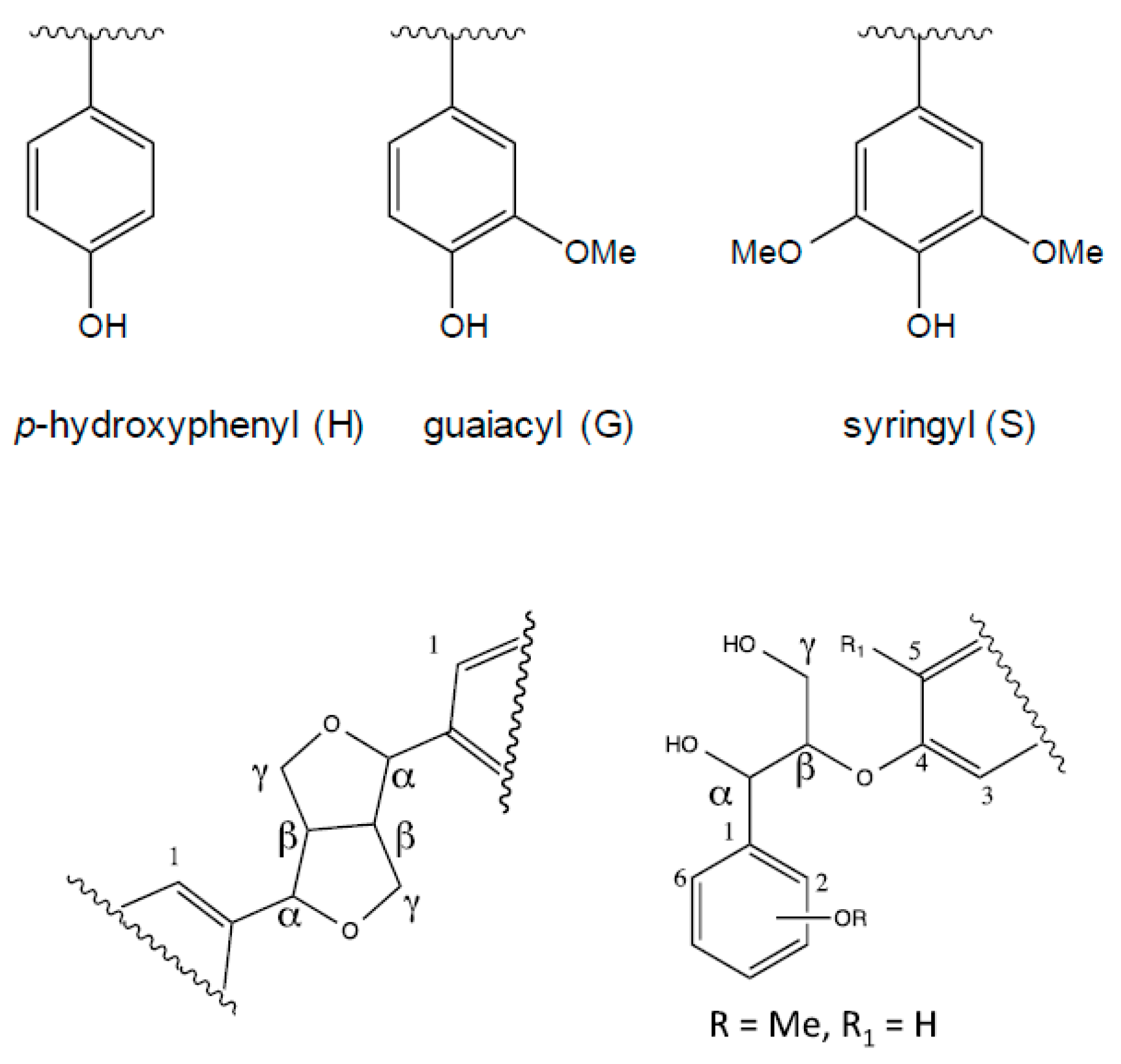


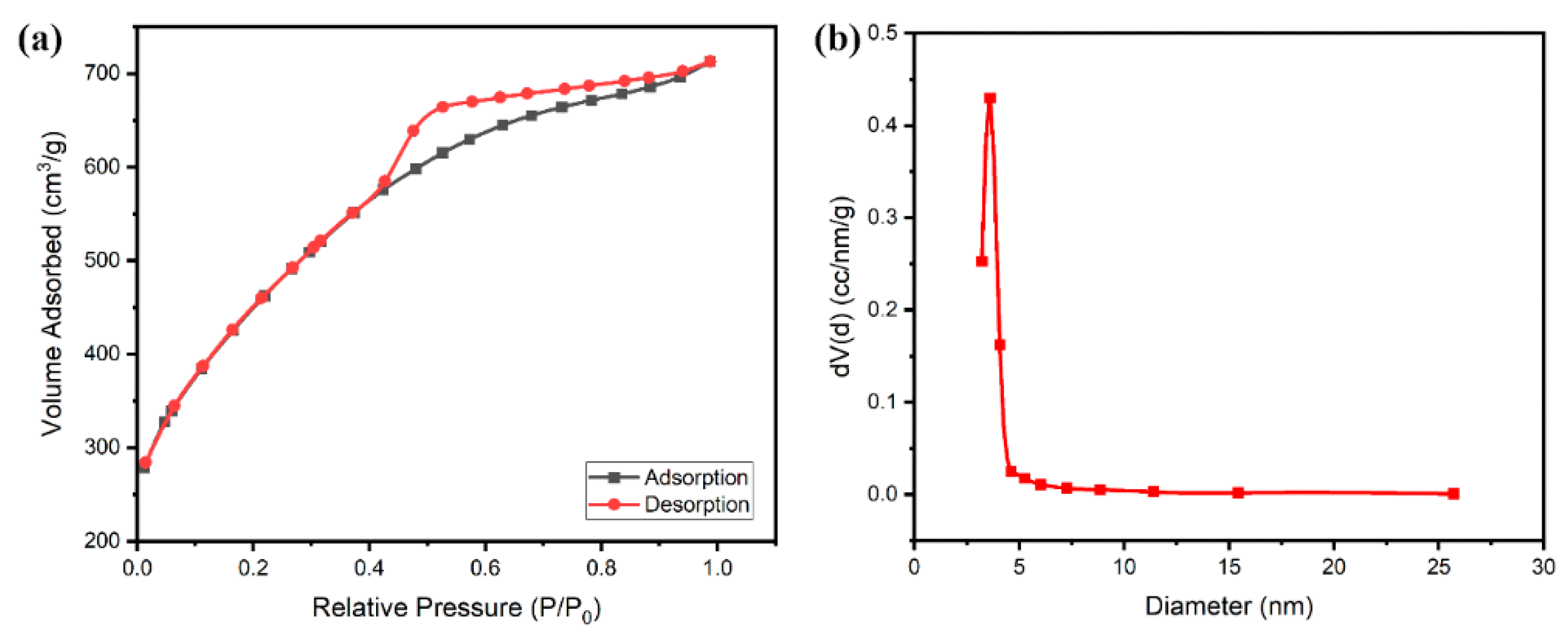
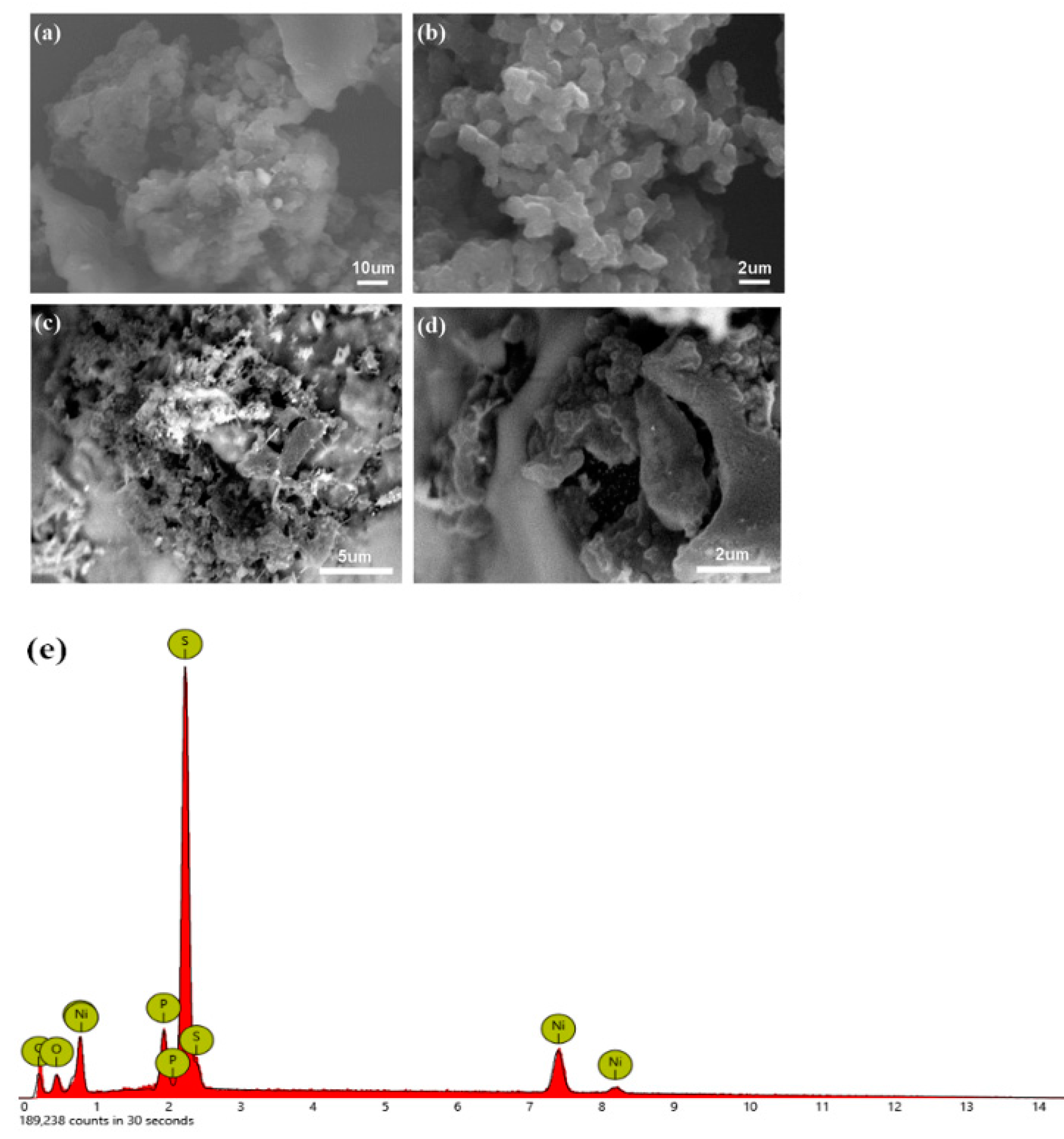
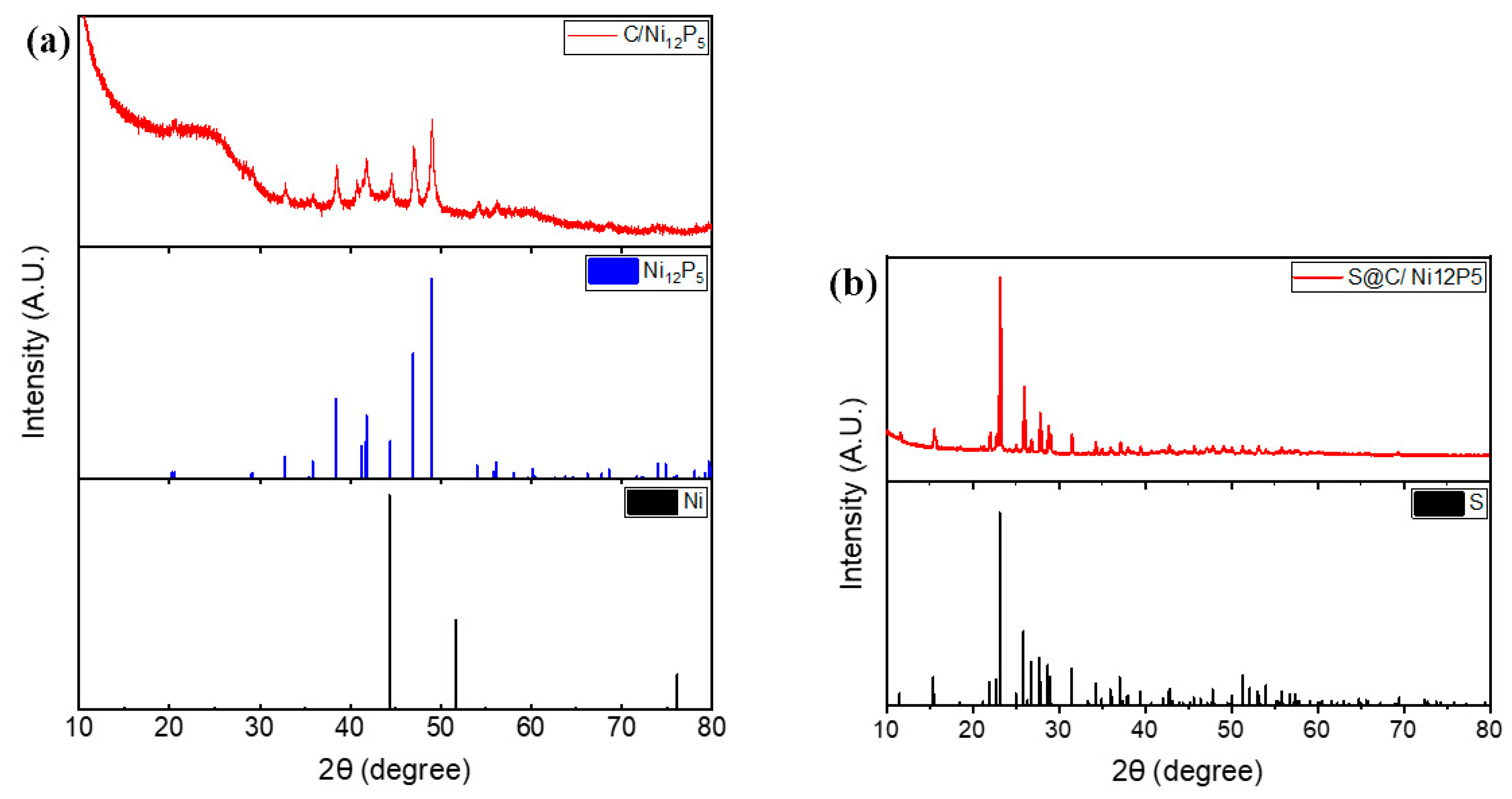
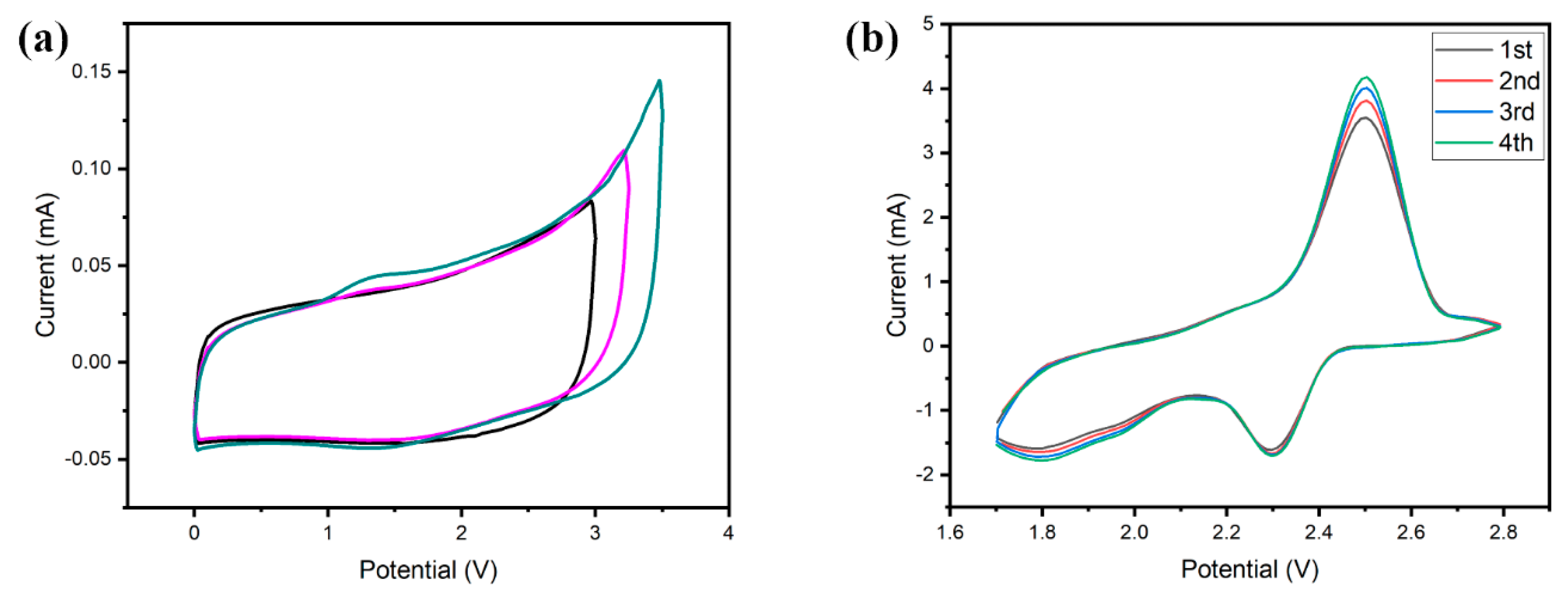
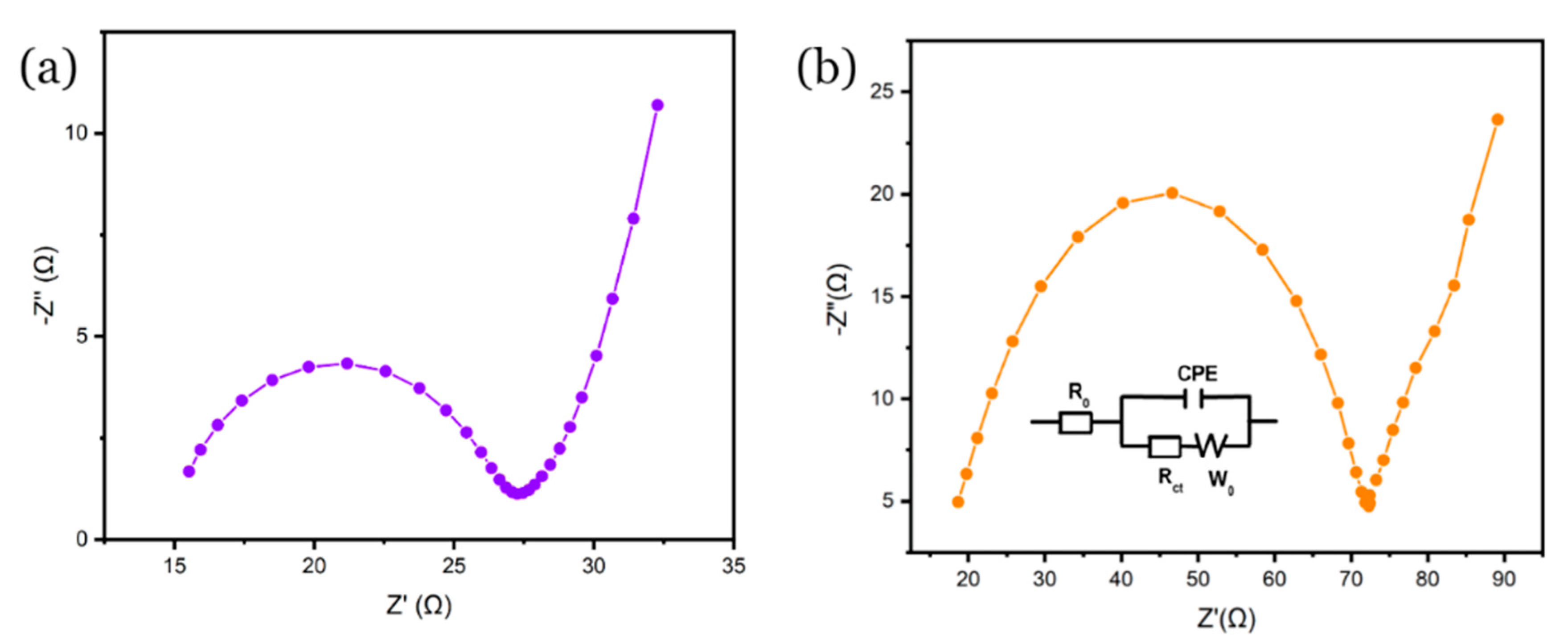


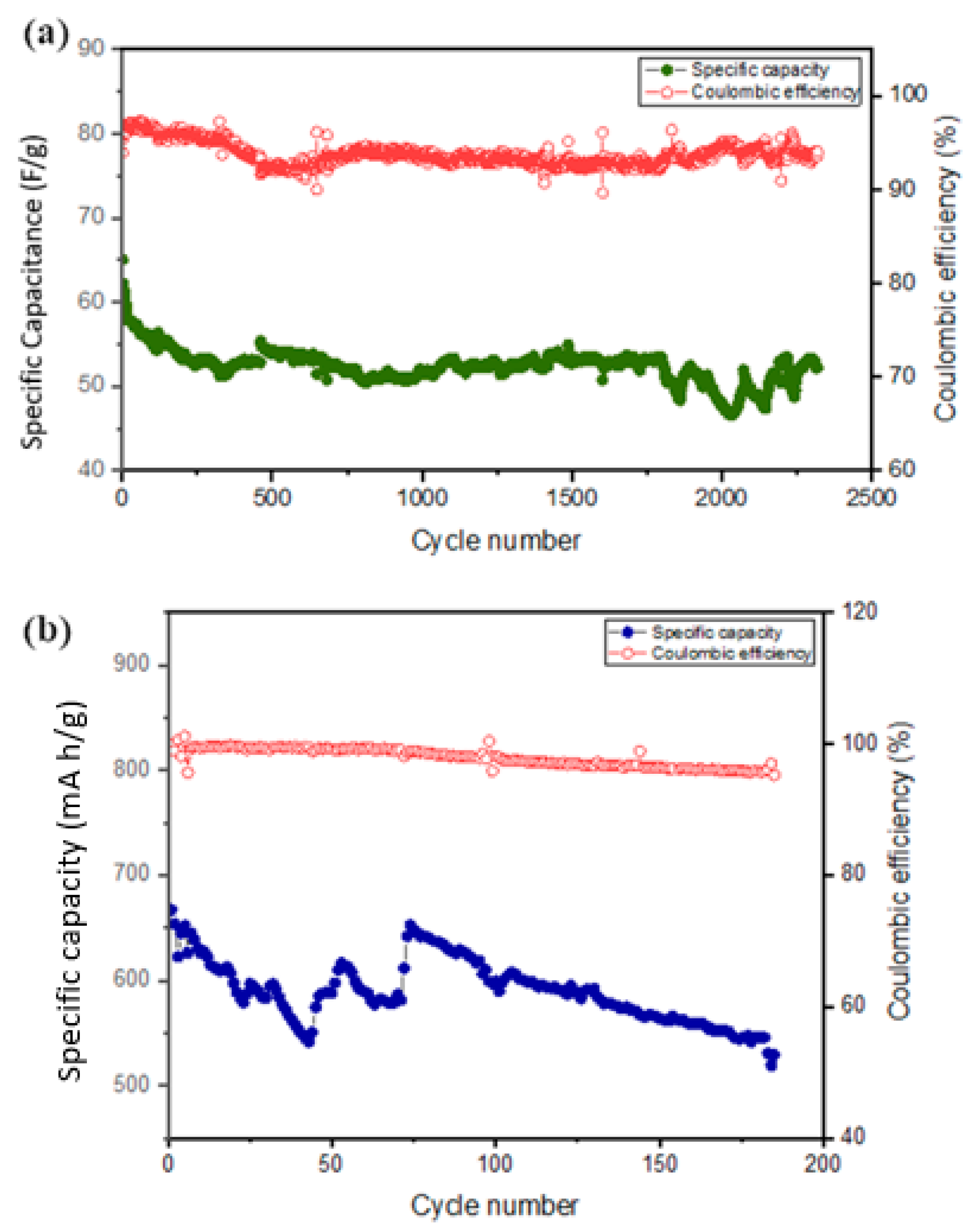
| HSAC No. | Formulation (g) | Method a | Carbonization | Yield (%) | Surface Area (m2 g−1) | Pore Volume (cm3 g−1) | Pore Diameter (nm) | Comments |
|---|---|---|---|---|---|---|---|---|
| 1 | Lignin (5) | M/F | 800 °C, 1 h 5 °C·min−1 | 21.9 | 1832.2 | 0.783 | 3.608 | Used in this project |
| KCl (15) | ||||||||
| Na2S2O3 (15) | ||||||||
| 2 | Lignin (5) | M/F | 800 °C, 4 h 5 °C·min−1 | 12.3 | 1735.2 | 1.246 | 3.609 | - |
| KCl (15) | ||||||||
| Na2S2O3 (15) | ||||||||
| CaCO₃ (15) | ||||||||
| Triton X100 (1.5) | ||||||||
| 3 | Lignin (10) | M/T | 800 °C, 4 h 2.5 °C·min−1 | 6.4 | 1677.2 | 1.499 | 0.614 | B-doped |
| KCl (30) | ||||||||
| Na2S2O3 (20) | ||||||||
| CaCO₃ (3) | ||||||||
| H₃BO₃ (1.5) | ||||||||
| 4 | Lignin (10) | M/T | 800 °C, 4 h 2.5 °C·min−1 | 9.4 | 1734.7 | 1.138 | 0.785 | N-doped |
| KCl (30) | ||||||||
| Na2S2O3 (20) | ||||||||
| CaCO₃ (3) | ||||||||
| Urea (4) | ||||||||
| 5 | Lignin (5) | M/F | 800 °C, 4 h 5 °C·min−1 | 20.3 | 1892.4 | 0.944 | 3.605 | B-doped |
| KCl (15) | ||||||||
| Na2S2O3 (15) | ||||||||
| H₃BO₃ (0.5) | ||||||||
| 6 | Lignin (5) | M/F | 800 °C, 4 h 5 °C·min−1 | 17.8 | 2112.3 | 0.667 | 3.61 | N-doped |
| KCl (15) | ||||||||
| Na2S2O3 (15) | ||||||||
| Urea (7) |
Publisher’s Note: MDPI stays neutral with regard to jurisdictional claims in published maps and institutional affiliations. |
© 2022 by the authors. Licensee MDPI, Basel, Switzerland. This article is an open access article distributed under the terms and conditions of the Creative Commons Attribution (CC BY) license (https://creativecommons.org/licenses/by/4.0/).
Share and Cite
Suzanowicz, A.M.; Lee, Y.; Schultz, A.; Marques, O.J.J.; Lin, H.; Segre, C.U.; Mandal, B.K. Synthesis and Electrochemical Properties of Lignin-Derived High Surface Area Carbons. Surfaces 2022, 5, 265-279. https://doi.org/10.3390/surfaces5020019
Suzanowicz AM, Lee Y, Schultz A, Marques OJJ, Lin H, Segre CU, Mandal BK. Synthesis and Electrochemical Properties of Lignin-Derived High Surface Area Carbons. Surfaces. 2022; 5(2):265-279. https://doi.org/10.3390/surfaces5020019
Chicago/Turabian StyleSuzanowicz, Artur M., Youngjin Lee, Abigail Schultz, Otavio J. J. Marques, Hao Lin, Carlo U. Segre, and Braja K. Mandal. 2022. "Synthesis and Electrochemical Properties of Lignin-Derived High Surface Area Carbons" Surfaces 5, no. 2: 265-279. https://doi.org/10.3390/surfaces5020019
APA StyleSuzanowicz, A. M., Lee, Y., Schultz, A., Marques, O. J. J., Lin, H., Segre, C. U., & Mandal, B. K. (2022). Synthesis and Electrochemical Properties of Lignin-Derived High Surface Area Carbons. Surfaces, 5(2), 265-279. https://doi.org/10.3390/surfaces5020019








